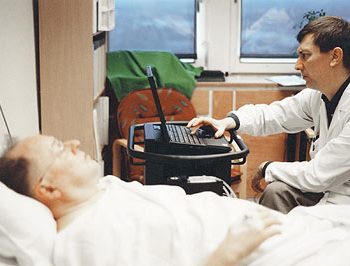Cystoenopapilloma and Lipoma - Benign breast tumors. They are not so common as fibroadenoma, but no less unpleasant. Let's learn what these tumors represent and what they threaten the breast.
Content
 Cystoenopapiloma - a benign swelling occurring from breast ducts. It represents either papillary growths in an extended duct, or similar growth in breast cyst. Distinguish multiple and single (solitary) cystoenopapillomas.
Cystoenopapiloma - a benign swelling occurring from breast ducts. It represents either papillary growths in an extended duct, or similar growth in breast cyst. Distinguish multiple and single (solitary) cystoenopapillomas. The causes of the occurrence are not clearly established. Cystoenopapilloma usually develops against the background of nodal or diffuse fibrous-cystic mastopathy, papillomas are formed in cystic and changed, extended ducts. It is believed that there is a dependence of the occurrence of papilloma from the pathologies of the hormonal background.
The main manifestation is the discharge from the nipple - serous (transparent) and bleeding. Often the discharge cause inconvenience, dirt underwear. Rarely, with large sizes, the tumor can be tugged. With a thorough breast palpation in the area of the area, seals are determined in the form of a rounded formation of an elastic consistency. The node is located in the near-block, central zone. When pressed on it, bloody drops appear from the mouth of the duct on the nipple. After the complete emptying of the duct from the contents of the tumor disappears. If the tumor walls are thickened due to the inflammatory process, then the tumor is dense and painful.
The survey includes ultrasound, mammography, cytological study of the discharge from the nipple. Additionally, mammography with contrast (the introduction of a contrast agent into mammary glands).
Single or multiple cystandeneopapillars are associated with increased risk of breast cancer. Cystoenopapilloma may flash and turn into breast cancer. But it does not always happen.
In this regard, it is recommended to treat these tumors. Surgical intervention is recommended for suspected illustration, expressed in any of the methods of examination. In the absence of data for rebirth may be observed. Operational intervention is usually carried out under general anesthesia and includes the removal of breast tissues, where Papilloma is located.
Previous operations were carried out with the removal of the nipple, which inevitably led to a cosmetic defect. Currently, operational interventions are performed while preserving a nipple (reducing the central zone). When the tumor is located outside the central zone of the breast, a standard sectoral resection is performed, in which damaged docks are removed through a small incision. During the operation, the shape and size of the chest are not subject to change. When the discharge of the tumor is detected, radical intervention is performed - mastectomy or organ-powder intervention.
For the prevention of cystandenopapillars, it is recommended to regularly undergo a tool examination at mammologist.
The causes of lipomas are unknown. It is believed that they arise as a result of clogging the outlet of the rowing gland, but the causes of this, and therefore, and the causes of the lipoma science have not yet been established.
Lipoma is not dangerous. Lipomas in subcutaneous fatty tissue are reborn quite rarely (in liposarcomas), in the Liposarcoma breast - an extremely rare phenomenon. Lipoma is not reborn in cancer.
Lipoma dimensions can vary from peas to rather large, comparable with the size of the child's head. Breast lipomas can intensively increase in size and deform the milk gland, and the growth of lipoma does not depend on the state of the body. It continues to grow, accumulating fat, even with general exhaustion.
Diagnosis is to conduct inspection, mammography, ultrasound, cytological research. But the most accurate diagnosis method is a computer tomography that allows you to clearly differentiate a fatty tissue, which is characterized by a low X-ray absorption indicator, with more dense soft-weddable structures.
As a rule, the tumor removal is recommended. Experts for operation are the large size of lipomas and localization at which functional disorders or cosmetic defect occur. Forecast is favorable, although lipoms can recur. Usually the enucleation of the tumor (deserted) is performed, less often (with suspected breast cancer) - sectoral breast resection.









